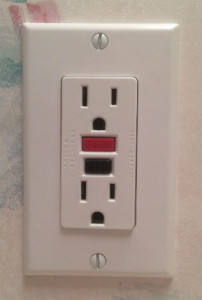Ground Fault Interrupter Safety
A Ground Fault Interrupter (GFI) is an electrical safety device designed to protect people from electrical shock, so proper maintenance is important. These special outlets have been regularly included in houses built or remodeled since the early 1980s.
A typical 120 volt outlet in the U.S. consists of two vertical slots and a rounded ground opening underneath. The left slot is slightly larger than the other slot and is called “neutral.” The smaller slot on the right is called the “hot” side. Under normal usage, the current flowing through both slots is the same. A GFI detects extremely small imbalances in the current flow. If the flow of current from the hot side is higher than the flow through the neutral side, say because the electricity accidentally flows from an old defective hair dryer you are holding in your hand to your other hand touching the water faucet (a ground fault), the reduction in flow through the neutral side is immediately detected. The electricity is cut off in about one-thirtieth of a second so you don’t get electrocuted.
Why am I telling you all this technical information? Because maintaining these GFI outlets in proper working order is important for the safety of you and your family. A lot of people don’t know that these outlet should be tested monthly to make sure they stay in proper working order. Just push the test button and you should hear a click and see the reset button pop up slightly as the power is disconnected. Then push the reset button to turn the power to the outlet back on. Keep in mind that one GFI outlet can be wired to protect the outlets in all your bathrooms, outlets near your kitchen sink, and your outdoor outlets. Even if you have never tested these outlets, now is a good time to start so you can keep them working properly or have them replaced. Modern hair dryers have a GFI built into their plugs, so test those too.



Leave A Comment